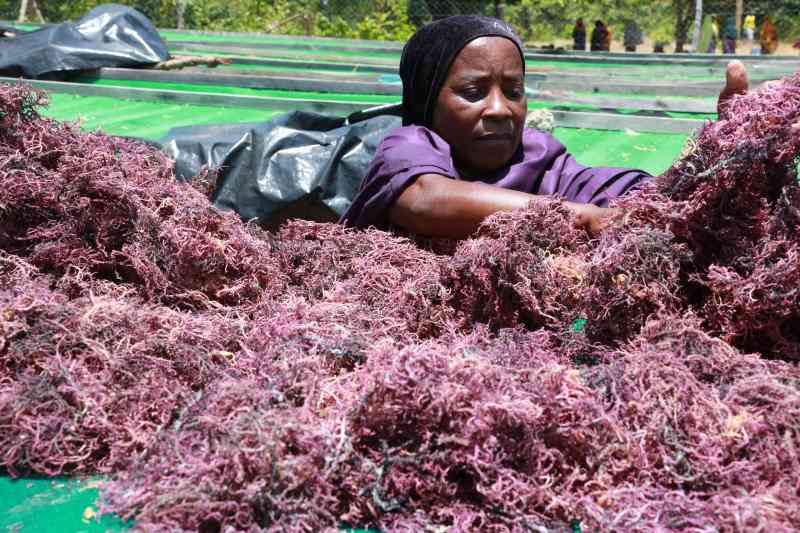Kenya’s first ever seaweed farm has weathered the storm since its establishment more than a decade ago as the price offered by buyers begins to rise and with it farmers’ profits.
A farm in Kibuyuni village in Shimoni, Kwale County has also increased its produce, largely on account of training offered by the Kenya Marine Fisheries Research Institute (KMFRI).
For a long time, Kibuyuni villagers viewed seaweed farming as subordinate to fishing until fish stocks began to run out on the back of a declining market for seafoods.
With attention now firmly focused on the Kibuyuni Seaweed Farmers Organisation, production quotas rose and today the group boasts 50 members, most of them women.
Fatma Mohamed Usi, the group’s chairperson, told Smart Harvest that the organisation was registered in 2012. With support from KMFRI, the group has found a new buyer who offers Sh30 per kilogramme of seaweed, up from an initial Sh9 per kilo.
The new buyer, East African Seaweed Company, buys and exports the raw material to markets in South Africa and China. Experts estimate that seaweed farming could earn the country up to Sh40 million annually and help uplift thousands of lives of those who depend on fisheries.
Commercially viable
KMFRI has been leading other research agencies in conducting studies on the commercial viability of seaweed farming. The studies have uncovered a market potential that could place the country in the same league as its neighbours Tanzania, which, for 20 years, has been supplying the global seaweed market with a sizeable product.
KMFRI first set up Kibuyuni, a seaside village of 2,500 people, as a model farm. Over the years, other farms have been developed at Mkwiro in Wasini Island with 1,000 people, Funzi with 1,000 inhabitants and Gazi with 15,000 residents.
“Seaweed farming has been identified as a good prospect for social and economic development of coastal areas. It is aimed at diversifying livelihood opportunities for poor fishing communities whose source of income has been seriously put at risk by diminished capture of fish,” said Morris Mukaraku, the officer in charge of the Corporate Affairs Department at KMFRI.
Extracts of dried seaweed are used as food thickeners and in the global pharmaceutical and cosmetic industries. Seaweed has also been used as an additive to soils, mainly in coastal areas where the partly dried seaweed is transported to areas that need to be fertilised.
The high fibre content of the seaweed acts as a soil conditioner and the mineral content as fertiliser.
Nassoro Mohamed, one of the farmers in the Kibuyuni group, says proceeds from the sale of seaweed has helped him support his family .
“There has been stiff competition for fish as the number of fishermen going out to sea has increased. I have had to look for other ways to boost my income. Seaweed farming has provided me with an alternative source of funds,’’ Mohamed says.
He observes that before competition for seafood became unmanageable due to the growing number of fishermen, he could raise Sh15,000 on a good day. But that is now history. “I hardly make Sh5,000 from fishing no matter how long I fish. My family needs a surplus from what I make from fishing. Seaweed farming has raised the family income,’’ he said.
Stay informed. Subscribe to our newsletter
Others have also benefited. Tima Mwalimu Jasho has utilised part of her savings from sea weed farming to put up a one bedroomed house which she plans to lease out.
At a secluded open beach on the edge of the otherwise sleepy Kibuyuni village lies the model farm which is visible during low tide but disappears at high tide. The farm is close to others that display the same product. At Kibuyuni, drying is done over open racks that rely solely on the sun.
Rising demand
From each farm, one metric tonne of dry seaweed is harvested every six weeks, translating to between eight to 10 harvests a year.
A metric tonne of produce at current market rates sells at Sh12,000. The seaweed is mainly exported to America and Asia where demand has been rising.
Two strains of seaweed known as Kappaphycus alvarezi (cottonii) and Euchuma denticulatum (spinosum) are available at the South Coast.
In the 1960s, Norway pioneered the production of the seaweed meal, made of dried and powdered brown seaweed which was used as an additive in animal feed.
The use of seaweed for food for humans has been traced back to the fourth century in Japan and the sixth century China.
Today, these two countries and South Korea are the largest consumers of seaweed foods and their requirements provide the basis of an industry that worldwide harvests six million tonnes of wet seaweed a year.
China is the largest producer of edible seaweeds, and the five million tonnes produced annually is largely for local consumption.
 The Standard Group Plc is a
multi-media organization with investments in media platforms spanning newspaper
print operations, television, radio broadcasting, digital and online services. The
Standard Group is recognized as a leading multi-media house in Kenya with a key
influence in matters of national and international interest.
The Standard Group Plc is a
multi-media organization with investments in media platforms spanning newspaper
print operations, television, radio broadcasting, digital and online services. The
Standard Group is recognized as a leading multi-media house in Kenya with a key
influence in matters of national and international interest.
 The Standard Group Plc is a
multi-media organization with investments in media platforms spanning newspaper
print operations, television, radio broadcasting, digital and online services. The
Standard Group is recognized as a leading multi-media house in Kenya with a key
influence in matters of national and international interest.
The Standard Group Plc is a
multi-media organization with investments in media platforms spanning newspaper
print operations, television, radio broadcasting, digital and online services. The
Standard Group is recognized as a leading multi-media house in Kenya with a key
influence in matters of national and international interest.






